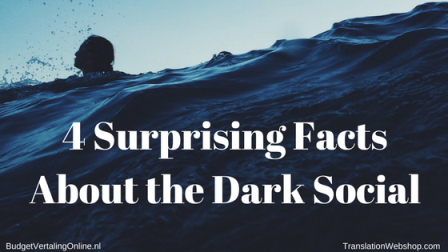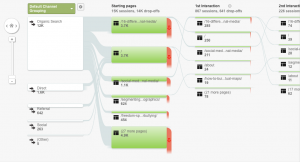September 30, 2016
The dark social is social content shared through private channels, rather than public platforms where posts can be seen and shared openly by a wide circle of people. The term was first described by Alexis C. Madrigal and examples include e-mail communications or chats on messaging apps. As this content is shared through private channels, it often exists beyond the reach of standard analytic tools and metrics that companies use to assess how and where content is shared.
That is where it gets interesting. If dark social is hard to track, how does an eager entrepreneur or marketer know that it is happening and how can you influence it? This blog offers 4 interesting facts about the dark social. After these 4 facts, you will know and understand the basics of dark social.

Fact 1: The dark social is NOT the dark web
The term dark social certainly gives people pause when they first hear it, says Brian Mastroianni, because it sounds like the “Dark Web” with its hackers, cyber terrorism, and illicit online content. However, it simply refers to personal communication that is happening “below the radar.”
It is as simple as copying and pasting a link, and sending it to your friend in an e-mail. Your friend may tweet it and get re-tweeted by followers, who then also click on it. The original site that houses the content has no idea that the traffic generated from that simple share stems from your original e-mail.
Mastroianni describes this as a domino effect with an untraceable chain, which carries with it implications for how brands and organizations need to assess their analytics better and how they are reaching users.
Fact 2: The dark social is a result of the need for more privacy
At the South by Southwest (SXSW) Interactive festival, Greg Swan and Marc Jensen talked about how people want to connect with each other, and how they will give up certain private information in exchange for value in how they communicate.
In social media, trends change rapidly. What is consistent, though, is the shift toward personal, private communications through larger social channels. For instance, members of Generation Z – the group born in 1996 or later – have gravitated away from the very public forums presented by social networks like Facebook and Twitter, and toward messaging apps that are immediate, visual, impermanent, and, most crucially, private.
It is a more intimate take on the kind of social media interaction that exploded in popularity over the past decade. With a rise in this messaging culture, dark social becomes increasingly significant.
Fact 3: The dark social encompasses most shares
In June 2016, RadiumOne published its report The Dark Side of Mobile Sharing. It clarifies that Facebook is responsible for 9% of the on-site shares globally, that all the other public social networks are responsible for 7% of the on-site shares globally, and that dark social is responsible for a whopping 84% of on-site shares globally! Can you believe that? Only 16% of shares is done in public. As you can see, dark social is definitely a trend to keep an eye on.
In addition, 38% of click backs on dark social shares come from desktops, while 62% of click backs on dark social shares come from mobile devices. If your website heavily relies on mobile traffic, you may see a high number of “direct links” in your analytics, as if people typed in your URL themselves, but it really is just dark social.
Fact 4: Dark social tracking is possible
By now, you know that focusing on dark social should be a priority for brands. Amanda Bathory explains what you need to do:
- Turn all content links into shortened, trackable URLs using a tool, such as Bit.ly, Post.ly or the Google URL builder. The short URLs can be used on social posts, e-mail campaigns, blogs, embedded in video, tests, press releases, QR codes, email signatures, search campaigns, offline campaigns, and ad tags.
- Share these trackable links every time you distribute your content.
- Save the URLs – with clear labelling – and share them with the wider marketing team.
- Measure the click backs and click through using your analytics package, and monitor where the traffic originates from.
- Calculate the use of dark versus light sharing by your audience by setting up a simple report in Microsoft Excel. Collate the referral source data and filter to show the social media channels. Create a formula that calculates a rolling percentage of shares via light methods, such as Facebook and Twitter, and create a separate formula that does the same for dark sources, such as email, instant messenger, or forums.
- Compare the data and tell the story of your content’s journey. Is Facebook really your greatest source of traffic? If it is WhatsApp, you should implement a WhatsApp share button on all your content.
- Act on the findings to tailor your content strategy to the dark side.
I hope this blog helps you understand the dark social a bit more. It is not as scary as it sounds. You can even facilitate dark social, if your analytics show that your audience wants this, by adding share buttons for dark social apps.
Digital & Social Articles on Business 2 Community(41)





